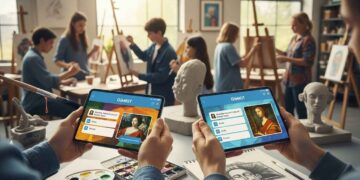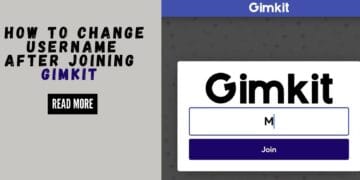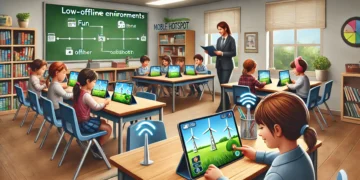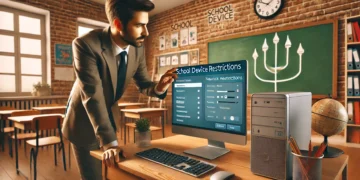Every teacher knows that look: the genuine frustration when a student struggles with a task that everyone else seems to manage effortlessly. In the dynamic, fast-paced world of digital games like Gimkit, that struggle often comes down to one fundamental element we sometimes take for granted: color.
Did you know that approximately 8% of your male students and 0.5% of your female students experience the world in different colors? That means, even in a small class, you likely have students who cannot distinguish between the red and green answers, or who lose their team’s avatar in a visually complex game mode. When a crucial instruction relies entirely on distinguishing specific hues, an otherwise engaging educational tool becomes an invisible barrier.
The big question in your inclusive classroom is: Can my colorblind student use Gimkit effectively?
While Gimkit is a fantastic, high-engagement platform, its official Gimkit accessibility settings for color blindness are currently limited. This absence forces reliance on color alone to convey critical information, creating a significant challenge for students with Color Vision Deficiencies (CVD). But don’t worry! This guide moves beyond the problem to offer immediate, practical, and highly effective workarounds.
Our goal is to ensure that Gimkit truly becomes one of the most color blind accessible educational games in your EdTech arsenal. This guide will provide honest transparency about current limitations and deliver actionable strategies—from device-level setup guides to question design tips—regardless of the platform’s current shortcomings. You’ll walk away with proven solutions for color blind gaming accommodations that you can implement today.
Understanding Color Blindness in Educational Settings
To solve a problem, you first have to understand what the student is seeing—or, in this case, not seeing. Addressing visual accessibility in education starts with empathy and accurate information.
While Gimkit is a highly engaging platform, educators must consider the needs of all students. Integrating digital tools into your curriculum is a great step toward creating engaging classrooms, and ensuring they are truly inclusive is crucial. We champion the use of accessible educational games for all learners, which means addressing potential accessibility gaps in platforms like Gimkit. For those new to the topic, color vision deficiency (CVD), or color blindness, simply means that a person sees colors differently from others. Understanding this is key to promoting Digital Equity across your EdTech tools.
What Is Color Blindness? (Medical Understanding Made Simple)
 Color blindness, or Color Vision Deficiency (CVD), is a common, typically inherited condition where the cone cells in the eye struggle to perceive certain wavelengths of light. It’s important to remember that it is not “blindness” in the traditional sense; it is a different visual perception.
Color blindness, or Color Vision Deficiency (CVD), is a common, typically inherited condition where the cone cells in the eye struggle to perceive certain wavelengths of light. It’s important to remember that it is not “blindness” in the traditional sense; it is a different visual perception.
Types of Color Vision Deficiency
The vast majority of color vision issues—over 99% of cases—fall under the red-green spectrum. This is where most digital learning platforms, including Gimkit, often fail due to their reliance on these colors.
Red-Green Color Blindness (Most Common – $\approx$99% of cases):
- Protanopia ($\approx$1% of males): The “red-blind” type. Red light is perceived as very dim, and red colors appear to be black or very dark gray. This can make red text on a dark background virtually invisible.
- Protanomaly ($\approx$1% of males): The “red-weak” type. Red, orange, and yellow colors appear greener and significantly dimmer.
- Deuteranopia ($\approx$1% of males): The “green-blind” type. Red appears brownish-yellow, and green appears beige. Reds and greens are virtually indistinguishable.
- Deuteranomaly ($\approx$6% of males, $\approx$0.4% of females): The “green-weak” type and the most common form of CVD. Students confuse shades of red, green, and brown, often seeing green and yellow as being redder than they are.
Blue-Yellow Color Blindness (Rare – $<$1% of population):
- Tritanopia: The blue cones are missing. Blue appears green, and yellow often appears violet or light gray.
- Tritanomaly: Blue and green are difficult to distinguish, and blues look desaturated.
Complete Color Blindness (Extremely Rare):
- Achromatopsia: The cones don’t function at all. The world is seen only in shades of gray, black, and white (monochrome). This affects about 1 in 30,000 people and is often accompanied by low vision and light sensitivity.
Statistics That Matter for Educators
These aren’t just medical statistics; they are classroom realities that require proactive planning:
- Global Impact: Approximately 300 million people worldwide have color blindness, equivalent to the entire population of the United States.
- Classroom Probability: Given the 8% male and 0.5% female prevalence, in a classroom of 25 students, you can reliably expect 1 to 2 students to be affected.
- Racial and Ethnic Data: While CVD affects all populations, some studies show slight variations. For instance, rates of red-green deficiency are generally lower in certain Indigenous groups compared to people of Caucasian descent, although comprehensive global data is still being collected.
- Undiagnosed Students: Many students, especially those with milder forms like deuteranomaly, remain undiagnosed until school age, when complex color-coded materials become routine.
How Color Blindness Affects Educational Gaming
 When a game relies on color as its sole indicator, it creates an instant disadvantage.
When a game relies on color as its sole indicator, it creates an instant disadvantage.
Common Challenges in Digital Learning Platforms
This issue extends beyond Gimkit to many other educational tools:
- Visual Identification Problems: A student cannot distinguish between the red team vs. green team icons, or they cannot tell if a colored progress bar is 80% full (green) or failing (red).
- Map/Diagram Reading: Complex science or geography diagrams that use color legends (e.g., red for hot, blue for cold) become incomprehensible.
- Graph Interpretation: In data visualization, a line graph that uses red and green lines to plot variables can turn into two indistinguishable, overlapping gray lines.
Gimkit-Specific Challenges
Color blind students using Gimkit often struggle most in high-pressure, visual modes:
- Team Mode Color Assignments: In competitive team modes like Tag: Domination, the colored zones or bases are the focus. If a student can’t see the difference between their blue home base and the enemy’s green one, they cannot play effectively.
- Power-Up Color Indicators: In a fast-paced game, the quick visual cue for a desirable power-up (e.g., green for positive, red for negative) is lost.
- Leaderboard Color Coding: Differentiating player positions or status (like “safe” or “out”) on the real-time leaderboard often uses color cues that fail to meet minimal WCAG color contrast ratios.
Many of Gimkit’s most popular modes rely heavily on color differentiation for identifying teams, tracking opponents, or highlighting key resources. Understanding these Gimkit-specific challenges is the first step toward mitigation.
Educational Impact Beyond Gaming
The impact of this visual barrier goes far beyond a missed power-up:
- Reduced Engagement: Confusion leads to frustration, causing students to withdraw or avoid participation.
- Slower Response Times: If a student has to take extra time to rely on the position or shape of an answer and not the color, they are disadvantaged in timed activities.
- Misdiagnosis: Persistent struggle with color-coded tasks can lead to a teacher mistakenly identifying a visual barrier as a learning difficulty or lack of effort.
Current State of Gimkit Accessibility Features (Honest and Transparent)
We love Gimkit for its innovation, but in the spirit of honesty and transparency, we must look critically at its native accessibility support.
What Gimkit Currently Offers (Honest Assessment)
 Gimkit’s greatest asset for accessibility is its design philosophy rather than dedicated features.
Gimkit’s greatest asset for accessibility is its design philosophy rather than dedicated features.
Built-In Accessibility Features
The following features offer indirect accommodations:
- Simple, Clean Interface Design: The minimalist look of Classic Mode inherently reduces visual clutter.
- Keyboard Navigation Capabilities: Students can navigate questions and select answers using the keyboard alone, minimizing reliance on precise mouse control or visual aiming.
- Text Customization Options: While limited, the platform often uses high-contrast text by default.
- Adjustable Game Speed: Certain modes allow the teacher to set a slower pace, which is an important, albeit indirect, accommodation for students needing more time to visually process adjusted colors.
NOTE: Based on ongoing research and formal accessibility reviews, Gimkit has faced challenges regarding full WCAG compliance, particularly concerning the use of color as the sole means of conveying information, confirming the limited native colorblind features.
What Gimkit Lacks (Transparency is Important)
This is the list of missing features that necessitate the workarounds detailed in the next section:
- No Dedicated Colorblind Mode: There is no single toggle in the Gimkit accessibility settings to adjust the game’s colors.
- No Customizable Color Palettes: Teachers or students cannot change the default red/green team colors to more distinguishable shades (e.g., blue/orange).
- Minimal Pattern/Shape Differentiation: Critical information (e.g., an incorrect answer) is flagged by color alone, without supplemental visual cues like a cross-hatch or a unique shape.
- No Official Accessibility Documentation: Gimkit’s help center currently lacks comprehensive guides or statements on compliance.
Why This Matters: Gimkit, by solely using color to convey meaning in its game modes, is not fully WCAG 2.1 AA compliant for color contrast and color dependence. This limits independent use by colorblind students and requires proactive, documented accommodations for IEP/504 integration.
While Gimkit has a strong foundation, full accessibility remains a work in progress. You’ll find that many of the core features of Gimkit focus on engagement and gamification, but a dedicated, high-contrast ‘Color Blind Mode’ is still a highly requested feature from the community. You can always check the official Gimkit Help Center for the latest updates on new features.
How Gimkit Compares to Other Educational Platforms
 Gimkit is not alone in its shortcomings, but the industry is moving quickly. Evaluating competitors shows us what is possible.
Gimkit is not alone in its shortcomings, but the industry is moving quickly. Evaluating competitors shows us what is possible.
Accessibility Feature Comparison
This table, focused on accessible quiz games for students, highlights the industry gap:
| Feature | Gimkit | Kahoot | Quizizz | Blooket |
| Dedicated Colorblind Mode | ❌ | ⚠️ Limited | ✅ Yes | ❌ |
| Customizable Colors | ❌ | ❌ | ✅ Yes | ❌ |
| Pattern Options | ⚠️ Limited | ❌ | ✅ Yes | ⚠️ Limited |
| Symbol Alternatives | ⚠️ Some | ⚠️ Limited | ✅ Yes | ❌ |
| Accessibility Docs | ❌ | ⚠️ Basic | ✅ Comprehensive | ❌ |
When choosing your EdTech stack, a comparative view is always helpful. For a deep dive into how Gimkit stacks up against another major player in gamified learning, check out our analysis: Gimkit vs. Blooket. Understanding these differences, as detailed by major organizations like Common Sense Education, can inform which platform you choose for specific review activities.
Competitor Strengths to Learn From
The comparison reveals that Gimkit lags behind its key competitor, Quizizz, in core accessibility features. Quizizz is a strong example of what Gimkit could adopt:
- Quizizz’s Strength: Offers a dedicated colorblind mode and the ability to customize colors, demonstrating a commitment to inclusive classroom technology.
- Industry Trend: The educational games sector is slowly improving, following the lead of major companies like Mattel’s commitment to colorblind-friendly design.
- What Gimkit Could Adopt: Implementing a simple overlay of pattern differentiation (e.g., stripes on one team’s area, dots on another’s) would instantly solve the red-green confusion problem without requiring major code overhauls.
Immediate Solutions for Colorblind Students Using Gimkit
Since Gimkit’s native support is limited, we must use the powerful color blindness education tools already built into our students’ technology. This is the practical guide to how to make Gimkit color blind friendly right now.
Device-Level Accessibility Settings
 These operating system (OS) settings apply a real-time, system-wide color filter, making them the most powerful and reliable tool for color blind gaming accommodations.
These operating system (OS) settings apply a real-time, system-wide color filter, making them the most powerful and reliable tool for color blind gaming accommodations.
Windows 10/11 Color Filters
Windows has excellent, built-in filters that target the specific types of CVD.
Step-by-Step Setup:
- Open Settings $\rightarrow$ Accessibility $\rightarrow$ Color filters.
- Toggle “Color filters” $\rightarrow$ ON.
- From the dropdown, select the filter that corresponds to the student’s deficiency. For the most common type, select Deuteranopia (red-green).
- Adjust the intensity slider if needed, then ask the student to test it on a Gimkit game.
Keyboard Shortcut: The most useful feature is the quick toggle: Press Windows key + Ctrl + C to turn the selected filter on or off instantly.
| Pros (✅) | Cons (❌) |
| ✅ System-wide solution (works everywhere) | ❌ Changes ALL colors (may look strange outside Gimkit) |
| ✅ Free and built-in (no installation needed) | ❌ Not customizable per application |
| ✅ Quick toggle for easy testing | ❌ May require different settings for different tasks |
macOS Display Accommodations
Macs, iPads, and iPhones offer similar, high-quality filters integrated into the display settings.
Setup Process:
- Go to System Settings $\rightarrow$ Accessibility $\rightarrow$ Display.
- Click the Color Filters button.
- Enable “Color Filters.”
- Choose the filter type: Protanopia, Deuteranopia, or Tritanopia.
- Adjust the intensity as needed until the Gimkit interface is clear.
Keyboard Shortcut: To quickly access Display Accessibility options, use ⌘ + Option + F5.
Chromebook Accessibility Features
Chromebooks, common in schools, rely slightly more on the Chrome browser environment.
- Chrome OS Settings:
- Click the time/status area in the bottom-right corner $\rightarrow$ Settings (gear icon).
- Select Accessibility $\rightarrow$ Manage accessibility features.
- Under the Display section, enable High contrast mode (good for text). You can also try Color inversion for a full color flip.
- Note on Filters: Since Chromebooks often lack the robust native color correction filters of Windows/Mac, using a Chrome Browser Extension (detailed next) that works specifically in the browser is often the best and most flexible approach for Gimkit.
iOS/iPadOS Color Filters
Accommodating color blind students using Gimkit on mobile devices is straightforward:
iPad/iPhone Setup:
- Go to Settings $\rightarrow$ Accessibility $\rightarrow$ Display & Text Size.
- Tap Color Filters.
- Toggle it ON.
- Select the filter type and adjust the intensity.
Accessibility Shortcut: Set up an accessibility shortcut so the student can triple-click the side button to quickly toggle the filters during a Gimkit game.
Android Device Settings
Android setup is manufacturer-dependent, but the functionality is there.
Android Setup (General):
- Go to Settings $\rightarrow$ Accessibility.
- Look for Color correction or Color inversion.
- Enable the correction and select the mode: Deuteranomaly, Protanomaly, or Tritanomaly.
Browser Extensions and Tools
 Browser extensions are ideal because they only affect the Gimkit website, leaving other apps on the device untouched. This is a powerful, non-system-altering way to implement color blind gaming accommodations.
Browser extensions are ideal because they only affect the Gimkit website, leaving other apps on the device untouched. This is a powerful, non-system-altering way to implement color blind gaming accommodations.
Chrome Extensions for Colorblind Users
Google Chrome offers the strongest ecosystem of extensions for visual accessibility in education:
- Color Blind Pal (Free): An excellent choice for real-time correction. After installation, click the extension icon and select the student’s CVD type. Switch to “Daltonize” mode to attempt to correct the colors into distinguishable shades, or use the “Simulate” mode to verify the visual problem.
- ColorBlindly (Free): Primarily a simulation tool for developers, it can also be used by students to test different views and find one that provides maximum color separation for the current Gimkit game.
- Color Enhancer (Free): The most flexible option for a power user. It allows for customizable color shifts, letting the user fine-tune a unique palette for a specific Gimkit game, which may be problematic.
- High Contrast (Google Official): This extension is a simple toggle that forces high contrast on any webpage, making sure text and buttons meet WCAG-compliant contrast standards.
For immediate relief, you can empower students to use tools that live outside the Gimkit application. Several high-quality Chrome Extensions for Colorblind Users can apply real-time color filters to the screen. The organization Color Blind Awareness also provides a comprehensive list of useful apps and software to help students see visual information better.
Gimkit Game Mode Selection for Accessibility
 The teacher’s choice of game mode can be the best accommodation of all.
The teacher’s choice of game mode can be the best accommodation of all.
Best Game Modes for Colorblind Students
Focus on modes that rely on text and personal progress, not team color or rapid spatial awareness:
| Recommended Modes | Why It Works | Strategy for Success |
| Classic Mode (Individual) | This mode is excellent because the core mechanics focus on answering questions and earning money. The best way to get familiar with this is first to learn how to play Gimkit yourself and observe how much of the gameplay is color-dependent. | Focus on the answer position and text, not the faintly colored button outline. |
| Trust No One | Highly social and text-based communication. Role indicators are the only color-based elements and can be described verbally. | Relies on deduction, not visual speed. Team up with a peer who can verbally confirm role colors. |
| Gimkit Assignments | For completely self-paced, non-competitive work, use Gimkit Assignments. This removes the high-pressure, visual-clash environment of a live game. | Time is not a factor, reducing anxiety and allowing for careful visual processing. |
Game Modes to Avoid or Modify
Be cautious with modes where color is essential for survival or strategy:
- Team Modes (KitCollab, Tag: Domination): The color-coded teams (Red vs. Blue vs. Green) are a major challenge.
- Workaround: Use descriptive team names (The Eagles, The Hawks) and assign the colorblind student to a team whose color they can see (e.g., if they are red-green colorblind, put them on the blue team).
- Creative Modes with Visual Elements: Custom maps often use color to delineate zones.
- Workaround: Before the game, describe the zones by their non-color properties: “The safe zone is the circle on the left; the danger zone is the square on the right.”
Teacher Strategies for Inclusive Gimkit Implementation
Technology is only half the solution. The other half is the thoughtful, intentional application of Universal Design for Learning (UDL) principles by the educator.
Question Design for Accessibility
 Accessibility starts with the content. Ensure your questions rely on text and contrast, not just color cues. This is an essential step when you customize Gimkit for targeted learning outcomes. For example, never ask a question like “Which of the red items on the screen is correct?” This practice aligns with the globally accepted guidelines for digital content outlined in WCAG 2.2 (Web Content Accessibility Guidelines).
Accessibility starts with the content. Ensure your questions rely on text and contrast, not just color cues. This is an essential step when you customize Gimkit for targeted learning outcomes. For example, never ask a question like “Which of the red items on the screen is correct?” This practice aligns with the globally accepted guidelines for digital content outlined in WCAG 2.2 (Web Content Accessibility Guidelines).
Avoiding Color-Dependent Questions
Do NOT use color to convey information:
❌ BAD: “Click the RED button to continue.” (Fails if the student can’t see red.)
❌ BAD: “Which bar is BLUE in the graph?” (Fails if the colors are distorted.)
❌ BAD: “Select all GREEN items.” (Creates a guessing game.)
Use Accessible Alternatives:
✅ GOOD: “Click the TOP button to continue.” (Uses position.)
✅ GOOD: “Which bar represents nitrogen? (third from left)” (Uses text/position.)
✅ GOOD: “Select all items with a STAR icon.” (Uses shape coding.)
Using Descriptions Instead of Color
When designing custom questions (KitCollabs) or referring to on-screen elements, follow these best practices:
- Describe Position: “The chart in the bottom-right corner.”
- Use Shapes and Patterns: Refer to an item as the “striped vs. solid” or “circular vs. square” icon.
- Reference Numbers/Letters: Use “option A” or “number 4” rather than “the yellow option.”
- Include Text Labels Always: Never use color as the sole label on a custom image; always include the word of the color or the function (e.g., label the red button STOP).
Classroom Accommodations
 Equity in education requires providing every student with what they need to succeed.
Equity in education requires providing every student with what they need to succeed.
Seating and Display Considerations
- Optimal Setup: Seat the color blind students using Gimkit closer to the main display (if you are projecting) to minimize glare and maximize contrast.
- Personal Devices: Ensure the student is using a personal device where the accessibility settings are already optimized.
Pairing and Peer Support
A thoughtful buddy system is an invaluable assistive technology.
- Thoughtful Pairing: Pair the colorblind student with a sighted peer. Their role is not to give answers, but to act as a “Color Scout,” quickly calling out color-dependent information: “It’s the left-hand red power-up,” or “The yellow team is winning.”
- Communication Strategies: Normalize this support. Encourage the student to communicate their needs: “Can you tell me the color of the object in the middle?” This model of healthy student self-advocacy.
Pre-Game Preparation
 An ounce of prevention is worth a pound of troubleshooting during a timed game.
An ounce of prevention is worth a pound of troubleshooting during a timed game.
Testing Accommodations Before Class
- Testing Protocol: Have the student log in early or dedicate the first two minutes of class to a “Test Run.” Run through a few questions in the selected game mode.
- Verification: Ask the student privately: “Can you clearly see the difference between the ‘correct’ button and the ‘incorrect’ button right now?” Adjust the device or browser filter settings on the spot.
Student Self-Advocacy Training
Teach students to take ownership of their needs, preparing them for college and career life. Explain the different types of color blindness simply and empower them to say: “I need the Deuteranopia filter turned on, please,” or “I need you to tell me the color of the target.”
IEP and 504 Plan Integration
For students with documented needs, Gimkit modifications can be integrated directly into their learning plan. When addressing specific challenges, consider a deeper dive into how to leverage Gimkit in Special Ed. For official guidance on accommodations, refer to the IDEA (Individuals with Disabilities Education Act) guidance from the U.S. Department of Education.
Documenting Color Blind Accommodations
 Documentation ensures continuity and legal compliance.
Documentation ensures continuity and legal compliance.
Sample IEP/504 Language
Use specific, measurable language when documenting accommodations for visual accessibility in education:
- Visual Accommodations: “Student will use device-level color filters (Deuteranopia setting) or approved browser extensions (Color Blind Pal) during all digital learning activities, including Gimkit.”
- Assessment Accommodations: “In color-intensive Gimkit game modes, the student will be provided with extended time (25% more) or alternative, non-color-coded assessment formats.”
- Technology Accommodations: “All color-dependent visual material provided in class will be supplemented with text labels, pattern differentiation, or verbal descriptions.”
In writing 504 plans, use clear, actionable language that addresses the digital environment. For support in crafting accommodations for students with learning disabilities, focus on non-visual alternatives for competition and navigation.
Collaborating with Special Education Staff
Share this guide with the IEP/504 coordinator. Demonstrate the current Gimkit accessibility settings workaround and advocate for clear documentation that protects the student’s right to an equivalent educational experience.
Legal Requirements and Compliance
 Color blindness is a covered disability, and schools must provide accommodations under ADA compliance and the Individuals with Disabilities Education Act (IDEA) if it impacts a student’s ability to access the curriculum. While color blindness alone may not require specialized IDEA services, it almost always necessitates a 504 plan.
Color blindness is a covered disability, and schools must provide accommodations under ADA compliance and the Individuals with Disabilities Education Act (IDEA) if it impacts a student’s ability to access the curriculum. While color blindness alone may not require specialized IDEA services, it almost always necessitates a 504 plan.
Documentation Best Practices
For every accommodation, keep a record of:
- The specific colorblindness type (if known).
- The specific accommodation used (e.g., “Windows Deuteranopia Filter enabled”).
- Student Feedback (Did it help? Did it cause distraction?).
- Game Mode Selections and any alternative assignments provided.
Advocating for Gimkit Accessibility Improvements
While we’ve focused on immediate fixes, true equity in education means advocating for the platform itself to improve.
Providing Constructive Feedback to Gimkit
 Your feedback, especially when framed with clear use cases and solutions, is the most powerful catalyst for change.
Your feedback, especially when framed with clear use cases and solutions, is the most powerful catalyst for change.
How to Contact Gimkit About Accessibility
- Official Channels: Submit a formal Feature Request through the Gimkit help center and send a detailed email to support@gimkit.com.
- Public Advocacy: Use social media (e.g., Twitter @gimkit) to publicly highlight the need for color blind, accessible educational games, referencing competitor features.
To ensure color accessibility becomes a priority, the best course of action is to submit formal requests. Share your classroom’s needs by contributing to Gimkit feature ideas through their official channels.
What to Include in Your Request
Use this template to provide effective feedback:
Subject: Accessibility Feature Request – Colorblind Mode for Color Blind Accessible Educational Games
Dear Gimkit Team,
I am a [grade/subject] teacher using Gimkit with [number] students. [Number] of my students have red-green color blindness and cannot distinguish team colors in modes like Tag: Domination. The reliance on red and green fails WCAG compliance and limits student independence.
REQUEST: I respectfully request the following accessibility features:
- A dedicated Colorblind Mode with adjustable palettes (like Quizizz).
- Automatic pattern/symbol alternatives (e.g., stripes and dots) to supplement color coding in all game modes.
BENEFIT: These features would allow the $\approx$8% of male students globally to use Gimkit independently, establishing Gimkit as a leader in inclusive classroom technology.
Thank you for considering these vital accessibility improvements.
School and District Advocacy
 Educators must champion the cause of accessible game design for classrooms when making EdTech decisions.
Educators must champion the cause of accessible game design for classrooms when making EdTech decisions.
Building the Case for Accessible EdTech
Talk to your administrators about:
- Legal Compliance: The risk of non-compliance with Section 504 when using inaccessible tools.
- Student Impact: The reality is that 8% of males are affected.
- Equity: The commitment to ensuring all students have an equal opportunity to access engaging learning tools.
District-Wide Accessibility Policies
Advocate for a policy that mandates:
- All new EdTech purchases require an accessibility review.
- Vendors must meet a minimum of WCAG 2.1 AA for all digital content and provide documentation.
Alternative Accessible Educational Gaming Platforms
When the accommodations are too complex, or the student needs a truly native accessible experience, other platforms may be necessary.
When Gimkit Isn’t the Right Fit
 It’s okay to use multiple tools. The goal is learning, not loyalty to a single platform.
It’s okay to use multiple tools. The goal is learning, not loyalty to a single platform.
More Accessible Quiz Game Alternatives
| Platform | Key Accessibility Features | Best For… |
| Quizizz | ✅ Built-in colorblind mode, custom colors, pattern options. | Students need maximum accommodations and customization. |
| Kahoot | ⚠️ Limited colorblind settings, basic high contrast options. | Occasional use when Gimkit is too visually complex. |
| Google Forms Quizzes | ✅ Simple, text-based, minimal color, screen reader compatible. | Pure assessment over gamification; zero barriers. |
| Blooket | ⚠️ Similar to Gimkit; requires the same workarounds. | Variety, but not accessibility improvement. |
If a student’s needs cannot be met through Gimkit’s current settings, you may need an alternative. You can discover the best games like Gimkit that offer robust color customization options or focus primarily on text-based interaction. For non-biased recommendations, review tools evaluated by the Center for Applied Special Technology (CAST).
Hybrid Approach Strategy
The most effective strategy is often a hybrid approach:
- Use Gimkit with accommodations for most students.
- Provide a highly accessible alternative, like a Quizizz game with the colorblind mode activated, for students struggling with the visual demands of Gimkit.
- Avoid Stigma: Offer the choice to all students—frame it as “different tools for different tasks,” not as “special treatment.”
Non-Digital Alternatives
 Sometimes, the simplest way is the best way.
Sometimes, the simplest way is the best way.
Low-Tech Accessible Options
When technology fails or a student is severely struggling, revert to zero technology barriers:
- Physical Response Cards: Use large A/B/C/D cards that the student can hold up.
- Whiteboard Activities: Use thick black markers on a white board.
- Oral Quizzing: Call on the student individually for their response.
This ensures the learning objective is met, and a backup plan is always ready.
Universal Design Principles for All Students
We move beyond simply accommodating a few students to designing for everyone—the heart of Universal Design for Learning (UDL).
Beyond Accommodation to Inclusive Design
 UDL benefits everyone, not just those with specific needs.
UDL benefits everyone, not just those with specific needs.
Universal Design for Learning (UDL) Framework
When applying UDL to an activity like Gimkit, we focus on providing:
- Multiple Means of Representation: Information is presented in various ways. This means using text + icons + position (redundant cueing strategies), not just color.
- Multiple Means of Action and Expression: Students can demonstrate learning flexibly. This is achieved by allowing students to type, click, or verbally respond.
- Multiple Means of Engagement: Different game modes offer collaborative and competitive options to match various preferences.
How UDL Benefits All Students
The principle is simple: What is necessary for some is beneficial for all.
- Clear Visual Hierarchy: Students with ADHD benefit from the high contrast and clear visual cues.
- Redundant Cues: English language learners benefit from icons and symbols supplementing text.
- Reduced Confusion: All students benefit from faster processing when they don’t have to strain to distinguish poorly contrasting colors.
Remember, focusing on accessibility is a Universal Design for Learning (UDL) implementation practice. Designing a kit to support diverse learners—not just those with color vision deficiency—improves the experience for everyone.
Troubleshooting Common Colorblind Accessibility Issues
Here are quick, real-world solutions for common problems that crop up during a Gimkit game.
Problem-Solution Quick Reference
Student Can’t Distinguish Teams in Team Mode
Immediate Solutions:
- Assign by Name/Position: Refer to teams by their name or location (Team North, Team South).
- Filter Check: Ensure the Windows/Mac/Browser filter is active and correctly set to the student’s CVD type.
- Long-Term: Advocate for Gimkit to add team names on the display instead of relying solely on colored names.
Student Can’t See Power-Ups or Indicators
Solutions:
- Verbal Confirmation: Announce power-up activations aloud: “Speed boost is active!”
- Strategic Selection: Instruct the student to choose power-ups based on their position in the list, not their appearance.
- Test New Filters: Experiment with the “Color Enhancer” extension to find a filter that makes the specific power-up colors distinguishable.
Student Slower to Respond in Timed Games
Accommodation:
- Extended Time: This is a vital IEP/504 accommodation. Add 25-50% time to the student’s total game time.
- Untimed Mode: Use Gimkit Assignments for review, where there is no real-time pressure.
- Focus on Accuracy: Prioritize accuracy over speed, adjusting grading accordingly.
Settings Not Working/Keep Resetting
Technical Troubleshooting:
- Clear Cache: Clear the browser cache and restart.
- Conflict Check: Disable all other browser extensions to check for conflicts with the color filter.
- Verify OS Save: Ensure the OS-level filter (Windows/Mac) is set to start automatically or use the quick toggle command to re-enable it.
Refer to our guide on Gimkit not loading for browser-specific fixes.
Student Embarrassed/Doesn’t Want Accommodations
Sensitivity Solutions:
- Private Conversation: Discuss needs one-on-one.
- Normalize: Explain that 8% of males are affected, and it is a common genetic trait, not a weakness.
- Subtle Implementation: Use browser extensions or OS settings that are active only on their device, making the accommodation virtually invisible to peers.
Teaching Color Blindness Awareness to All Students
An inclusive classroom culture is the most sustainable inclusive classroom technology.
Creating Empathy Through Education
Age-Appropriate Lessons About Color Vision
- Elementary (K-5): Focus on kindness and inclusion. “Some friends see colors differently. How can we help everyone play the game fairly?”
- Middle School (6-8): Introduce the science of cones and genetics. Use simulation activities to foster empathy: “How would YOU redesign this game to solve the problem?”
- High School (9-12): Discuss genetics and the career implications of CVD. Focus on Universal Design as a social justice issue.
Hands-On Activities
- Simulation Exercises: Use a website like Coblis or a simulation app to have students view a Gimkit screenshot with different CVD filters applied. Discuss the feeling of frustration when they can’t see the critical information.
- Design Challenges: Challenge students to “Redesign this Gimkit question to be colorblind-friendly,” forcing them to use patterns, shapes, and clear text instead of color.
Building an Inclusive Classroom Community
Normalizing Diverse Needs: Explain that everyone has different needs—some need larger text, some need audio, and some need color filters. Accommodations are simply tools that ensure everyone can access the same high-quality learning experience.
Teaching students to be mindful of their classmates’ needs is a core component of digital learning. This aligns perfectly with lessons on digital citizenship and empathy in a competitive online environment.
Future of Accessibility in Educational Gaming
The landscape is changing, and our advocacy is driving that change.
Emerging Trends and Technologies
AI-Powered Accessibility Solutions
The next generation of EdTech will feature:
- Real-time Color Correction: AI that automatically detects and fixes poor color contrast in any game.
- Personalized Profiles: Platforms will remember a student’s deuteranopia setting across all games and devices.
- Voice Control: Voice commands to navigate or select answers, bypassing visual input entirely.
Industry Movements Toward Inclusion
Major game companies are adopting colorblind modes, and educational standards are increasingly requiring accessibility. This momentum will eventually reach Gimkit.
What We Can Expect from Gimkit
 Our advocacy should create realistic expectations for the platform’s response.
Our advocacy should create realistic expectations for the platform’s response.
| Timeline | Realistic Possibilities | How to Accelerate Change |
| Short-term (6-12 months) | Basic High Contrast Option, Accessibility Documentation, and Better support for browser extensions. | User feedback volume and frequency. |
| Long-term (1-3 years) | Dedicated Colorblind Mode, Customizable Color Palettes, Pattern/symbol alternatives, Full WCAG compliance. | Collective advocacy from districts, mentioning accessibility as a purchasing criterion. |
While an immediate update is unlikely, it is helpful to keep an eye on official announcements. We track and analyze the predictions for Gimkit’s roadmap to inform educators of upcoming changes that might address these accessibility gaps.
Conclusion
Colorblind accessibility in Gimkit is undeniably challenging due to the platform’s current design choices, but it is eminently manageable with the right strategies.
The most powerful tools in your arsenal are not found in Gimkit’s settings but in your commitment to Universal Design for Learning and the technology already available on your students’ devices. By following this guide, you can:
- Implement Immediate Fixes: Use device-level color filters (Win+Ctrl+C) and browser extensions (Color Blind Pal) to instantly correct color confusion.
- Use Mindful Design: Choose less color-intensive game modes and create questions that rely on position, text, and shape coding, not just color.
- Ensure Legal Compliance: Document your strategies in IEP/504 plans, ensuring your students’ right to access their education is protected.
- Drive Change: Provide constructive feedback to Gimkit, accelerating the industry’s shift toward creating truly color blind, accessible educational games.
Every student deserves engaging, equitable learning experiences. While Gimkit doesn’t currently offer dedicated colorblind features, your awareness, advocacy, and accommodation strategies ensure that all students can participate in engaging, game-based learning. By implementing the solutions in this guide, you’re not just helping the 8% of male students—you’re creating a more inclusive, smarter classroom for everyone.
Don’t wait! Test the accommodations in this guide with your students today, provide feedback to Gimkit, and share your successful strategies with a colleague. Inclusion is an ongoing commitment, not a one-time fix.
Frequently Asked Questions
General Colorblind Accessibility Questions
Q1: Can colorblind students use Gimkit effectively?
A: Yes, with accommodations. While Gimkit lacks native colorblind features, students can use device-level color filters, browser extensions, strategic game mode selection, and teacher support to participate fully. This guide provides multiple proven strategies for color blind accessible educational games.
Q2: What percentage of students might have color blindness in my class?
A: Approximately 8% of males and 0.5% of females have some form of Color Vision Deficiency. In a typical class of 25 students, you likely have 1-2 affected students. The most common type is red-green color blindness (Deuteranomaly).
Q3: Is color blindness considered a disability requiring accommodations?
A: Yes, under Section 504 of the Rehabilitation Act and the Americans with Disabilities Act (ADA), schools are required to provide accommodations for students with color vision deficiency to ensure equal access to the curriculum. A 504 plan is the typical vehicle for documenting these visual accommodations.
Q4: Which type of color blindness is most common?
A: Deuteranomaly (green-weakness) is the most prevalent type, affecting about 6% of males and 0.4% of females. Red-green color blindness collectively makes up over 99% of all color vision deficiencies.
Technical Setup Questions
Q5: What’s the easiest way to help a colorblind student use Gimkit?
A: The fastest and most reliable solution is enabling device-level color filters.
- Windows: Use the shortcut Win + Ctrl + C to toggle the selected filter on and off quickly.
- macOS: Navigate to System Settings > Accessibility > Display > Color Filters.
This is a system-wide solution that requires no installations and is essential for color blind gaming accommodations.
Q6: Do colorblind accessibility settings slow down gameplay?
A: No, modern operating system color filters and lightweight browser extensions do not typically affect a device’s performance or game speed. However, a student may need slightly more processing time to visually locate information using the newly adjusted colors, which should be addressed with extended time accommodations.
Q7: Can I use colorblind filters only for Gimkit, not everything?
A: Yes! Using a browser extension (like Color Blind Pal or ColorBlindly) is the best way to achieve this. These tools only affect the web content within the browser window, leaving other desktop applications (like word processors or email) with normal colors.
Q8: Which browser works best with colorblind accessibility tools?
A: Google Chrome offers the most robust selection of third-party accessibility extensions for colorblind users. Firefox also has several good add-ons. For Mac/iOS users, while Safari extensions are limited, the native macOS Display Accommodations are excellent and should be prioritized.
Classroom Implementation Questions
Q9: Should I announce a student’s color blindness to the class?
A: Only with explicit student and family permission. Many students prefer privacy. Instead of singling them out, you should normalize accommodations for everyone: “We all have different tools that help us learn. Some use colorblind filters, some use larger text, and some prefer a quieter spot.”
Q10: What Gimkit game modes work best for colorblind students?
A: Classic Mode (individual play), Trust No One, and Gimkit Assignments are the least color-dependent and work best. You should avoid or heavily modify team modes (like Tag: Domination or KitCollab) where quick, accurate color recognition is central to the strategy.
Q11: How do I create colorblind-friendly Gimkit questions?
A: You must rely on redundant cueing (providing more than one way to identify an answer).
- DO NOT use color references: e.g., “click the red button.”
- DO use position: “click the button on the top right.”
- DO use shapes/patterns: “select the starred item” or “the striped bar.”
- Always include text labels on custom images to achieve visual accessibility in education.
Q12: What if colorblind settings make the game look weird to other students?
A: The device-level color filters and browser extensions are applied only to the individual student’s display. Other students in the classroom see the game with normal colors. The accommodation is discreet and affects no one else.
Legal and Documentation Questions
Q13: What should I include in a 504 plan for a colorblind student?
A: A strong IEP/504 integration for color vision deficiency should include:
- Access to assistive technology (colorblind filters, browser extensions).
- Alternative formats for all color-coded materials.
- Extended time (or untimed modes) for color-intensive tasks.
- Use of text labels/patterns instead of color alone in all digital content.
Q14: Is Gimkit legally required to be accessible for colorblind users?
A: Gimkit, as a private EdTech vendor, is not directly regulated by Section 504 or the ADA. However, schools that purchase and use Gimkit are legally required to ensure that the content is accessible to all students. Therefore, the school must provide the accommodations detailed in this guide to compensate for Gimkit’s current limitations.
Q15: How do I document accommodations for colorblind students?
A: Keep detailed records of: the student’s specific CVD type (if known), the specific Gimkit color blindness settings guide strategies tried (e.g., “Deuteranopia filter on Mac”), student feedback on the strategy’s effectiveness, and any alternative assignments provided. This documentation is critical for IEP/504 compliance.
Advocacy and Future Questions
Q16: Has Gimkit announced plans for colorblind accessibility features?
A: As of 2025, Gimkit has not publicly announced a dedicated, fully-developed colorblind mode. Continued advocacy is necessary. Educators should submit specific feature requests to support@gimkit.com detailing the issues faced in game modes like Trust No One and Tag: Domination.
Q17: Are there better alternatives to Gimkit for colorblind students?
A: Yes, Quizizz is currently considered a leader among accessible quiz games for students, as it offers a built-in colorblind mode and customizable color schemes. Teachers should consider a hybrid approach, using Quizizz for color-sensitive activities while supplementing with Gimkit for its unique engagement features, all while maintaining accommodations.
While Gimkit is great, other platforms may offer superior accessibility features. Read our full feature-by-feature comparison of Gimkit vs. Socrative to see if another platform better suits your classroom’s accessibility requirements.
Q18: How can I advocate for Gimkit to add accessibility features?
A: Contact Gimkit support with specific, actionable requests (e.g., “Please add a pattern overlay on team zones”). Mention the importance of WCAG compliance and use your school/district’s purchasing power as leverage. Collective, specific feedback is the most effective way to push for inclusive design.



























